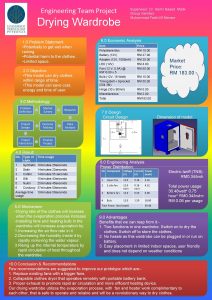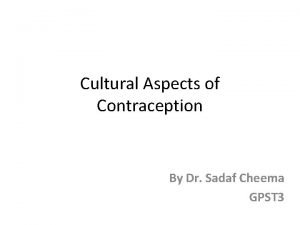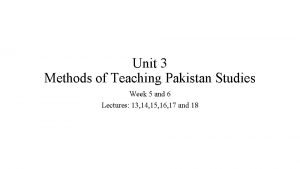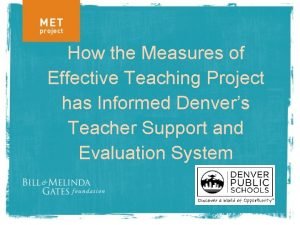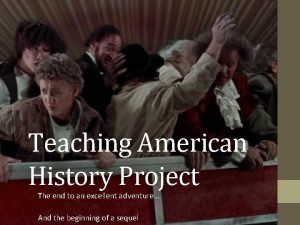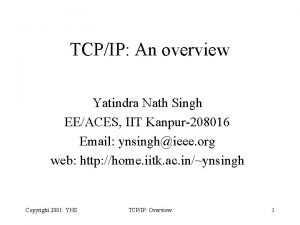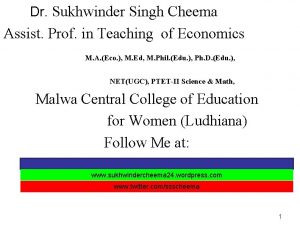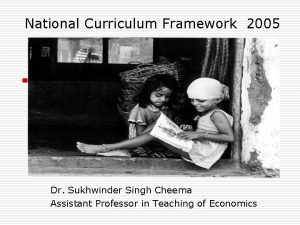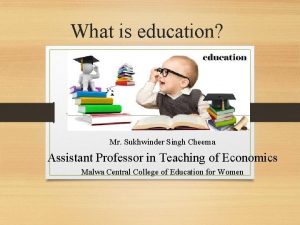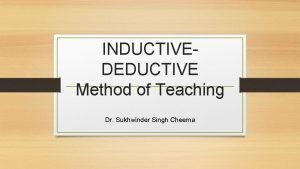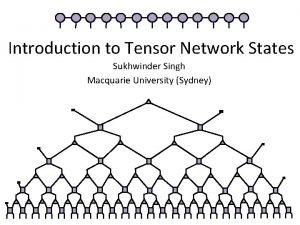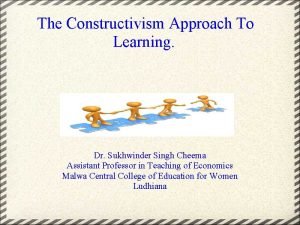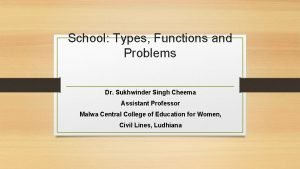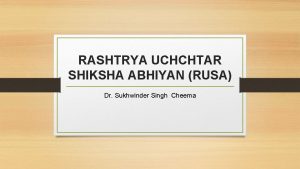PROJECT METHOD OF TEACHING Dr Sukhwinder Singh Cheema













- Slides: 13

PROJECT METHOD OF TEACHING Dr. Sukhwinder Singh Cheema

Background History • John Dewey a father of Pragmatism School of Philosophy, Promoted this school of Method in his BOOK, “My Pedagogical Creed”(1897) • He projected Idea that, “Learning by doing” is a the Best method of Learning and Teaching. • Markham (2011) describes that, “Project based Learning(PBL) integrate Knowing and Doing”

Meaning of Project • Project is an Activity willingly undertaken by Pupils in which emphasis is on learning by doing

Definitions According to Kilpatrick “A project is a whole- hearted purposeful activity proceeding in a social environment”. According to Stevenson (1908) “A project is a problematic act carried to completion in its natural setting”. According to Ballard “A project is a bit of real life that has been imparted into the school”.

Characteristics of Project on the basis of Definitions • • Whole hearted activity: by choice Purposeful activity: Aim full / objective centred Inside or outside the school Child centred Cooperative Individual differences Based on real experiences

Basic PRINCIPLES • Principle of Purposefulness: Why doing certain things? • Principle of Activity: Child is active by nature, has instinct of curiosity, and energetic, should involve in physical and mental activities • Principle of Freedom: choose as per their interest, need and capacity • Principle of Experiment: real experience has long lasting impression • Principle of Learning by doing: Best method of learning • Learning by living: Correlation with life • Children learn better through association, cooperation

Basic PRINCIPLES • Principle of Social Development : • Children learn better through association, cooperation and activity Principle of wholesome education: Can’t teach in Watertight compartment need to give wholesome experience Principle of reality: Should be near to life reality Principle of Utility: Project should be useful for individual and society • Principle of Planning: Project demand planning

TYPES OF PROJECT • Individual and Social (Group) projects: • Simple and Complex project: • Constructive project: is also known as Creative projects and involve mental activity( Cognitive) • Aesthetic project: Involve artistic skills i. e. decoration or presentation of data • Problematic project: aimed to solve a complex problem by using mental/ Intellectual Process • Drill project: which depends upon certain degree of skills to attain work efficiency

STEPS / Procedure of Project method • 1. Creating Situations: • Create problematic situations, which demand heavy efforts • 2. Selection of the problem: as per time, finance and individual efforts • 3. Fixing Objectives: • What we want to achieve after completion of project • 4. Planning: Scheme, allocation of duty, collection and generation of resources, fund raising etc.

STEPS / Procedure of Project method • 5. Execution: • Everybody paly its role to make it successful. Teacher monitor it • 6. Evaluation: • Teacher and students will evaluate jointly in the light of predetermined objectives, strengths and weakness, Mistake which were eye openers • 7. Reporting and Recording: • Report writing for review at any time • Recording for future consultation

ROLE OF THE TEACHER A guide, friend and philosopher. Helps the students in solving their problems. Encourages his students to work collectively, and cooperatively. Helps his students to avoid mistakes. He makes it a point that each member of the group contributed something to the completion of the project. Teacher should always remain alert and active during execution step and see that the project goes to completion successfully. During execution of the project teacher should maintain a democratic atmosphere. Teacher must be well – read and well-informed so that he can help the students to the successful completion of the

ADVANTAGES It is a method of teaching based on psychological laws of learning. It is students centered, activity based method. This method develops the problem solving ability to the students. It imbibes the spirit of cooperation as it is a cooperative venture. Stimulates interest in natural as also man made situations. It develops self-confidence and self-discipline and spirit of enquiry. A project can be used to arouse interest in a particular topics as it blends school life with outside world. It makes the students as independent. It gives the real work experience to the students. It develops the social qualities and synergism in the students’ heart. It develops the responsibility realization of the students. By this the students organizes the planning things in an order.

LIMITATIONS It is a time consuming method. It is a very costly method as it involves tours, excursions, purchase of apparatus and equipments etc. All topics are not able to teach through this method. It is not applicable for all the schools. Good textbooks on these lines have not yet been produced. The method of organizing instruction is un-systematized and thus the regular time table of work will be upset. Sometimes the projects may be to ambitions and beyond pupils capacity to accomplish.
 Delinking of degrees from jobs npe 1986
Delinking of degrees from jobs npe 1986 Sarwan singh kundan singh
Sarwan singh kundan singh Dr aamir cheema
Dr aamir cheema Sadaf cheema
Sadaf cheema Project method of teaching
Project method of teaching Meaning of micro teaching
Meaning of micro teaching What is symposium method
What is symposium method Teachingenglish org uk
Teachingenglish org uk Measures of effective teaching project
Measures of effective teaching project Teaching american history project
Teaching american history project Sandeep singh jolly berlin
Sandeep singh jolly berlin Yatindra nath singh
Yatindra nath singh Daljit nagra singh song
Daljit nagra singh song Alankrita singh ips
Alankrita singh ips


